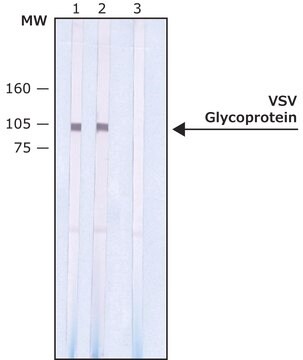A1970
Anti-VSV-Glycoprotein−Agarose antibody, Mouse monoclonal
clone P5D4, purified from hybridoma cell culture, PBS suspension
Synonyme(s) :
Monoclonal Anti-VSV Glycoprotein
About This Item
Produits recommandés
Source biologique
mouse
Niveau de qualité
Conjugué
agarose conjugate
Forme d'anticorps
purified immunoglobulin
Type de produit anticorps
primary antibodies
Clone
P5D4, monoclonal
Forme
PBS suspension
Classe(s) chimique(s) de l'analyte
proteins (VSV-G)
Technique(s)
immunoprecipitation (IP): suitable
protein purification: suitable
Isotype
IgG1
Capacité
≥15 nmol/mL, resin binding capacity (VSV-G tagged fusion protein)
Conditions d'expédition
wet ice
Température de stockage
2-8°C
Vous recherchez des produits similaires ? Visite Guide de comparaison des produits
Description générale
Spécificité
Immunogène
Application
Immunoprecipitation (1 paper)
Forme physique
Notes préparatoires
Vous ne trouvez pas le bon produit ?
Essayez notre Outil de sélection de produits.
Code de la classe de stockage
10 - Combustible liquids
Classe de danger pour l'eau (WGK)
nwg
Point d'éclair (°F)
Not applicable
Point d'éclair (°C)
Not applicable
Certificats d'analyse (COA)
Recherchez un Certificats d'analyse (COA) en saisissant le numéro de lot du produit. Les numéros de lot figurent sur l'étiquette du produit après les mots "Lot" ou "Batch".
Déjà en possession de ce produit ?
Retrouvez la documentation relative aux produits que vous avez récemment achetés dans la Bibliothèque de documents.
Notre équipe de scientifiques dispose d'une expérience dans tous les secteurs de la recherche, notamment en sciences de la vie, science des matériaux, synthèse chimique, chromatographie, analyse et dans de nombreux autres domaines..
Contacter notre Service technique







